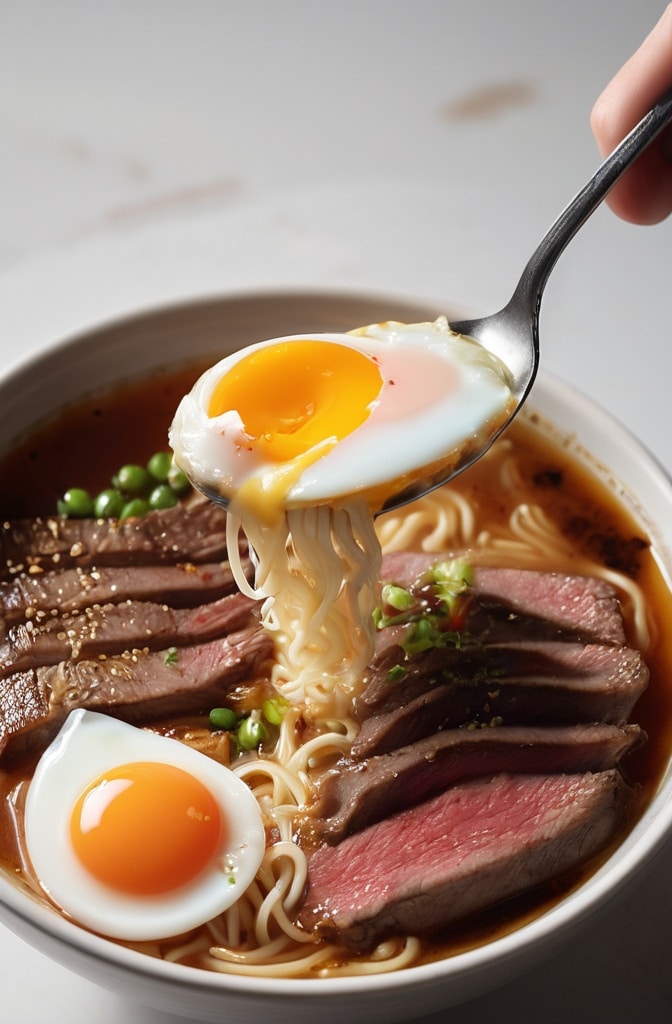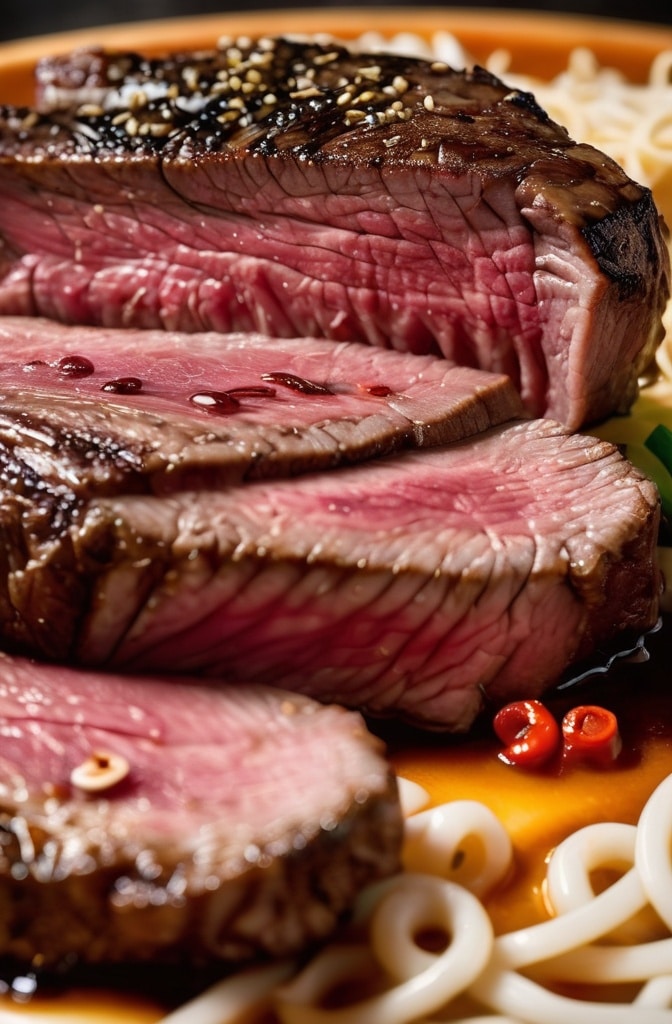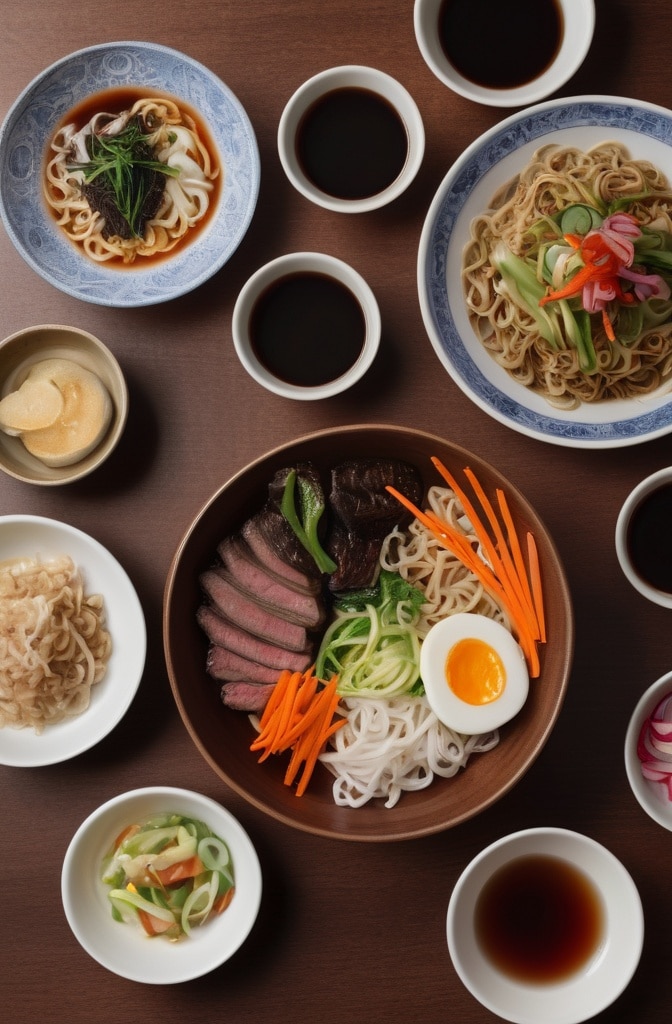The Ultimate Guide to Steak Stir-Fried Ramen
The sizzle of thinly sliced beef hitting a scorching wok still takes me back to my days training under Chef Lin in Shanghai. There’s something almost primeval about that sound and smell—it connects directly to our most basic instincts. Ever wondered why the humble ramen package collecting dust in your pantry could be transformed into something extraordinary? Steak stir-fried ramen isn’t just another quick meal; it’s what happens when East meets West on a plate, creating a perfect symphony of textures and flavors.

I’ve spent twenty years perfecting this particular fusion dish, and I’m finally ready to share my definitive approach. Trust me, this aint your college dorm room ramen.
Ingredients & Substitutions
For the Steak Marinade:
- 1 pound ribeye or sirloin steak, sliced paper-thin (freeze partially for easier slicing)
- 2 tablespoons soy sauce (preferably Japanese dark soy)
- 1 tablespoon Shaoxing wine (sub dry sherry in a pinch)
- 2 teaspoons cornstarch
- 1 teaspoon baking soda (the secret tenderizer)
- 1/2 teaspoon white pepper (black works too but changes the visual appeal)
For the Stir-Fry:
- 2 packages (6-8 oz) fresh ramen noodles (dried work too, but fresh delivers superior chew)
- 3 tablespoons neutral oil with high smoke point (peanut, avocado, or grapeseed)
- 4 cloves garlic, minced
- 2-inch knob ginger, julienned
- 3 scallions, whites sliced thinly, greens cut into 1-inch segments
- 1 carrot, julienned
- 6 shiitake mushrooms, stemmed and sliced (wood ears make a fasinating substitution)
- 1 small bok choy, leaves separated and bases trimmed
For the Sauce:
- 3 tablespoons oyster sauce (vegetarian mushroom oyster sauce works brilliantly)
- 2 tablespoons dark soy sauce
- 1 tablespoon light soy sauce
- 1 tablespoon toasted sesame oil
- 1 tablespoon brown sugar or honey
- 1/2 teaspoon five-spice powder (optional, but adds incredible depth)
- 1-2 teaspoons chili oil or sambal oelek (adjust to your heat preference)
Garnishes:
- Toasted sesame seeds
- Thinly sliced fresh chilies
- Cilantro leaves
- Lime wedges
- Soft-boiled marinated egg (ajitsuke tamago)
The quality of your beef matters tremendously here. Choose well-marbled cuts like ribeye or sirloin. For budget options, flank steak works surprisingly well when sliced against the grain and properly marinated. The baking soda in the marinade is non-negotiable—it breaks down proteins and creates that remarkable “restaurant-style” tenderness that most home cooks miss.
For vegans, king oyster mushrooms sliced into strips provide a meaty alternative with remarkable texture. Marinate them exactly as you would the beef. You won’t believe the similarity.
Step-by-Step Instructions
Preparing the Steak
- Place your steak in the freezer for 15-20 minutes until firmer but not frozen solid. This makes achieving those paper-thin slices infinetly easier. Using your sharpest knife, slice against the grain as thinly as humanly possible.
- Combine all marinade ingredients in a bowl, add the sliced steak, and massage gently with your hands (never use metal utensils with raw meat marinades). The cornstarch and baking soda work together to tenderize and create a protective coating that will keep the meat juicy during the high-heat cooking process. Let marinate for at least 30 minutes, but no more than 2 hours—beyond that, the texture becomes oddly mushy.
- While the steak marinates, prep all your vegetables and mix the sauce ingredients in a separate bowl. This mise en place is critical because once you start stir-frying, even blinking seems to take too much time. Having everything ready means the difference between perfectly cooked ingredients and a disappointing mess.
Cooking the Ramen
- Bring a large pot of water to a boil. Unlike Italian pasta, ramen doesn’t need salted water. Cook the noodles for exactly 1 minute less than package directions—they’ll finish cooking in the wok. Drain immediately and rinse under cold water to stop the cooking process and remove excess starch. Toss with a tiny bit of oil to prevent sticking. This might seem fussy, but properly cooked noodles make or break this dish.
- Heat your wok or largest skillet until it’s smoking hot. No, hotter than that. When you flick a droplet of water and it instantly evaporates with a hiss, you’re at proper stir-fry temperature. Add 1 tablespoon of oil, swirling to coat. Working in batches to avoid overcrowding (the arch-enemy of proper searing), add half the marinated beef in a single layer. Let it sear undisturbed for 30 seconds before stir-frying for another 30 seconds until just browned outside but still slightly pink inside. Remove to a clean plate. Repeat with another tablespoon of oil and remaining beef.
- In the same wok, add the remaining oil. Throw in the garlic, ginger, and scallion whites, stirfying for just 15-20 seconds until fragrant but not brown. Add harder vegetables (carrots) first, followed 30 seconds later by mushrooms, then bok choy stems, stirring constantly. Common mistake: overcooking vegetables destroys the textural contrast that makes this dish special.
- Add the drained noodles and sauce, tossing energetically with tongs or chopsticks to coat evenly. Return the beef to the wok along with any accumulated juices (liquid gold for flavor). Add the scallion greens and bok choy leaves, tossing until the leaves just wilt—about 30 seconds.
- Kill the heat immediately. Residual heat will continue cooking everything to perfection. Over-stirfrying is probably the most common error home cooks make—remember that ingredients keep cooking even after the heat is off.
Plating & Serving
Transfer to warmed bowls immediately. Unlike some dishes that benefit from resting, stir-fried ramen is at its textural peak right off the wok. Garnish with your chosen toppings—I’m particularly partial to the combination of sesame seeds, fresh chilies, and a perfect ajitsuke tamago with its jammy center.

For an extra dimension, serve with additional chili oil or house-made chili crisp on the side. The contrast between the silky noodles, tender beef, and crunchy chili oil creates what I call the “texture trifecta.”
Cooking Techniques & Science
The magic of stir-fried ramen lies in understanding two critical scientific principles: controlled protein denaturation and the Maillard reaction. The cornstarch-baking soda marinade creates a protective alkaline environment that keeps the beef incredibly tender while promoting faster browning. This technique, called “velveting” in Chinese cooking, prevents the meat from toughening when exposed to high heat.

Why a screaming hot wok matters: proper stir-frying relies on what Chinese chefs call “wok hei” (breath of the wok)—a complex combination of caramelization and partial combustion that occurs only at temperatures above 425°F (218°C). This imparts smoky complexity impossible to achieve at lower temperatures. Home stovetops rarely reach ideal temperatures, so I recommend heating your wok for a full 3-5 minutes until it starts to smoke before adding anything.
The order of operations is non-negotiable in stir-frying. Meat first, remove, aromatics second, vegetables in order of density, noodles and sauce near the end. This precise sequence ensures each component cooks perfectly without anything turning mushy or tough.
Ramen noodles deserve special attention. Their alkaline nature (thanks to kansui or baking soda in the dough) gives them their distinctive chew and allows them to hold up in stir-frying better than other noodle types. The pre-cooking step where we cook them 1 minute less than directed is crucial—they’ll absorb sauce and continue cooking in the wok without becoming soggy.
One technical aspect home cooks often miss is managing the wok’s temperature throughout cooking. After searing the beef, the wok will have darkened slightly and perhaps even smoked a bit. Don’t clean it! Those brown bits (fond) contain concentrated flavors that will dissolve into your sauce, creating depth professional chefs call “complexity layers.”
Serving & Pairing Suggestions
Steak stir-fried ramen sits at a fascinating culinary crossroads, allowing for creative serving approaches. For family-style service, bring the entire wok to the table on a heatproof trivet (dramatic and preserves temperature). For individual plating, use warmed bowls with high edges—practical for both temperature retention and chopstick manipulation.

Garnishing is where you can really express yourself. Beyond traditional options, consider:
- Furikake (Japanese seasoning blend)
- Crushed wasabi peas for unexpected crunch
- Paper-thin slices of watermelon radish for color and peppery contrast
- Crispy fried shallots
- A raw egg yolk nestled in the center (to be stirred in tableside)
Beverage pairings depend on your dominant flavor notes. For spicier versions, nothing beats an unfiltered Japanese rice beer (nigori sake works wonderfully too). If you’ve leaned into the umami richness, a medium-bodied red wine like Pinot Noir cuts through beautifully. For non-alcoholic options, cold-brewed hojicha (roasted green tea) offers tannic complexity that refreshes the palate between bites.
Side dishes should provide contrast rather than competition. Simple options like quick-pickled cucumbers with rice vinegar and sesame oil or a small bowl of chilled silken tofu with bonito flakes and light soy create balance without overwhelming the star of the show.
Conclusion
Steak stir-fried ramen represents perfect culinary synthesis—taking humble ingredients to extraordinary heights through technique and understanding. The true secret isnt exotic ingredients or equipment, but rather respect for timing, temperature, and texture. With practice, this dish becomes less about following steps and more about developing intuition.
Common problems home cooks encounter include tough meat (solved by proper slicing, marinade, and brief cooking), soggy noodles (solved by undercooking initially and managing stir-fry time), and bland results (solved by proper wok heat and sauce distribution).
Remember that this dish is forgiving in ingredients but demanding in technique. Focus on mastering the high-heat cooking process, and variations will come naturally as you develop confidence. Perhaps most importantly, stir-fried ramen reflects cooking’s greatest lesson: simple ingredients transformed through skill and attention become something far greater than the sum of their parts.
Frequently Asked Question?
Can I make this with pre-cooked or leftover steak?
Absolutely, but with adjustments. Slice your leftover steak (medium-rare works best) thinly against the grain. Skip the marinade and add the meat only at the very end of cooking, just long enough to warm through—about 30 seconds. Overcooking will make it tough. The flavor won’t penetrate as deeply as freshly marinated meat, so consider adding an extra splash of soy sauce directly to the sliced steak before adding.
How can I get restaurant-quality results on a home stove?
The limitation of home equipment is real. To maximize heat, use a carbon steel wok (it responds to temperature changes faster than other materials), preheat it for 3-5 minutes until smoking, and cook in smaller batches. Another professional trick: remove the wok from heat briefly between batches to allow it to recover its maximum temperature. Also, consider investing in a portable butane burner for outdoor use—they often provide better BTUs than standard home ranges.
Is there a make-ahead version of this recipe?
While stir-fries generally shine when freshly made, you can prep smartly. Marinate the beef up to 12 hours ahead (refrigerated). All vegetables can be prepped and stored in separate containers with damp paper towels. The sauce can be mixed days in advance. Even the noodles can be cooked, chilled, and lightly oiled up to a day ahead. Final stir-frying should still happen just before serving, but with all components ready, it takes less than 5 minutes.
How do I adapt this for a large dinner party?
Instead of making one giant batch (which would create steaming rather than stir-frying), prepare components separately and combine: Stir-fry meat in batches and keep warm in a low oven. Cook vegetables and noodles with sauce in 2-3 separate batches depending on wok size. Combine everything in a large, warmed serving vessel just before bringing to the table. For truly large gatherings (10+), consider setting up a live stir-fry station—it’s theatrical and ensures perfect texture.
What’s the best way to store and reheat leftovers?
Store in an airtight container for up to two days. Contrary to popular approaches, the best reheating method isn’t microwave but rather a quick refresh in a hot skillet with a tablespoon of water and drops of sesame oil. Cover briefly to steam (30 seconds), then uncover and stir-fry until just heated through. The water creates steam that revitalizes the noodles while the fresh sesame oil reawakens the flavors.

Veronica is a passionate food enthusiast with over three years of experience in exploring and writing about diverse cuisines. Her expertise lies in reviewing restaurants, sharing creative recipes, and discovering the latest food trends. As the voice behind FoodieRecap.com, Anju brings fresh perspectives and culinary insights to her audience.
